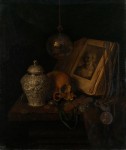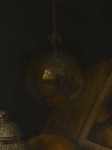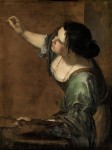 Royal Collection conservators have unmasked a hidden self-portrait of the artist in Pieter Gerritsz. van Roestraten’s A Vanitas (c.1666–1700). It’s an unexpected find in still life symbolizing the fleeting nature of life and the material things we value. The vanitas was a flourishing theme in Dutch art of the 17th century, and Roestraten’s scene includes some of the most popular imagery of the genre. Coins and a medallion hanging from a Mr. T-like thicket of chains represent all those worldly goods that you can’t take with you, a skull and cinerary urn represent the certainty of death, an open pocket watch on a silk ribbon signifying transience, Democritus, known as the Laughing Philosopher, laughs at human folly from the pages of a book captioned “Everyone is sick from birth / vanity is ruining the world,” and hanging from a string above the table is a glass orb representing the fragility of life.
Royal Collection conservators have unmasked a hidden self-portrait of the artist in Pieter Gerritsz. van Roestraten’s A Vanitas (c.1666–1700). It’s an unexpected find in still life symbolizing the fleeting nature of life and the material things we value. The vanitas was a flourishing theme in Dutch art of the 17th century, and Roestraten’s scene includes some of the most popular imagery of the genre. Coins and a medallion hanging from a Mr. T-like thicket of chains represent all those worldly goods that you can’t take with you, a skull and cinerary urn represent the certainty of death, an open pocket watch on a silk ribbon signifying transience, Democritus, known as the Laughing Philosopher, laughs at human folly from the pages of a book captioned “Everyone is sick from birth / vanity is ruining the world,” and hanging from a string above the table is a glass orb representing the fragility of life.
 The rest of the room is reflected in the orb, but before conservation, all you could really see was the light shining through window panes and a bulbous shape that has to be the skull but doesn’t look like much of anything. Still, Roestraten is known for concealing surprise images in his paintings and at least nine of them are tiny self-portraits hidden in reflections in glass and mirrors. Hoping his Vanitas might have just such an Easter egg, Royal Collection conservators set to cleaning it in anticipation of the upcoming exhibition Portrait of the Artist
The rest of the room is reflected in the orb, but before conservation, all you could really see was the light shining through window panes and a bulbous shape that has to be the skull but doesn’t look like much of anything. Still, Roestraten is known for concealing surprise images in his paintings and at least nine of them are tiny self-portraits hidden in reflections in glass and mirrors. Hoping his Vanitas might have just such an Easter egg, Royal Collection conservators set to cleaning it in anticipation of the upcoming exhibition Portrait of the Artist
During the removal of discoloured varnish, Royal Collection Trust conservators found the 3cm-high image of the artist at his easel painted as a reflection on the glass sphere. Roestraten can be seen in the surroundings of his studio, looking directly at the viewer and towards the skull and silver ginger jar in the foreground of the picture.
Anna Reynolds, Senior Curator of Paintings, Royal Collection Trust, and co-curator of the exhibition, said, ‘Vanitas paintings traditionally focus on symbolic objects that are designed to make us think about how we live our lives. The discovery of Roestraten’s reflection, previously hidden beneath a layer of varnish, is very exciting and adds a new element to the work – a sort of pictorial game that encourages us to look more closely.’
 A Vanitas with its newly exposed self-portrait will go on display in Portrait of the Artist along with more than 150 artworks from the Royal Collection that feature the artist in his or her own creation. Other stand-out pieces are a self-portrait drawing of Annibale Carracci (ca. 1575-80), the famous profile red chalk drawing of Leonardo da Vinci attributed to his student Francesco Melzi (ca. 1515-18), Jan de Bray’s The Banquet of Cleopatra (1652) in which he used himself and his family as models, a self-portrait by Sir Peter Paul Rubens (1623) and one my personal favorites, Self-portrait as the Allegory of Painting by Artemisia Gentileschi (ca. 1638-9).
A Vanitas with its newly exposed self-portrait will go on display in Portrait of the Artist along with more than 150 artworks from the Royal Collection that feature the artist in his or her own creation. Other stand-out pieces are a self-portrait drawing of Annibale Carracci (ca. 1575-80), the famous profile red chalk drawing of Leonardo da Vinci attributed to his student Francesco Melzi (ca. 1515-18), Jan de Bray’s The Banquet of Cleopatra (1652) in which he used himself and his family as models, a self-portrait by Sir Peter Paul Rubens (1623) and one my personal favorites, Self-portrait as the Allegory of Painting by Artemisia Gentileschi (ca. 1638-9).
Fascinating discovery !! Thanks for sharing.
Self portraits were, in some way, the exact opposite of vanitas paintings. One reminds the viewer of the fleeting nature of life and the other celebrates the permanent legacy of the artist. He will die, of course, but his name and work will remain forever.
I love 17th century Dutch vanitas paintings, but they are quite alarming.
That’s an awesome painting! I love the skull especially.
And it’s hard to tell, but I’d like to think the artist is grinning wickedly at us from behind his easel.